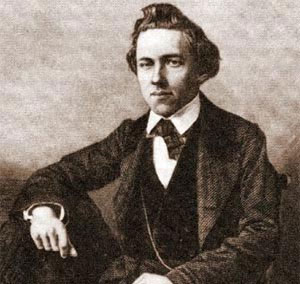 Time to look at lessons from historical figures: We’ll start with an ‘unofficial’ world champion, Paul Morphy.
Time to look at lessons from historical figures: We’ll start with an ‘unofficial’ world champion, Paul Morphy.
‘The Pride and Sorrow of Chess‘ was Morphy’s nickname. He stopped playing at the peak of his fame, leaving chess fans wanting more even now. (Put ‘morphy’ into Google and see!)
‘Finding the Crush‘: Morphy looked for the fastest path to a win, often with startling results. For our purposes, try in your own games to look for forceful variations that simply ‘look good’. (Look for variations where you ‘call the tune’.)
This way your method for improvement a la Morphy becomes simple and clear: When you are looking at a position you don’t grasp, try to choose simple, forceful tactics and threats first and consider more complex tactics or strategic stuff later. (‘Forceful’ tactics are moves you make that the opponent must respond to, such as a pawn threatening to move ahead for an attack or when you capture a piece or take territory. ) When things look too complex, try to forcefully simplify by exchanging pieces.
You will quickly learn that what ‘looks good’ often actually *is* good! (You will also no doubt learn that studying the position can never be ignored, with mistakes aplenty – but practice this way anyway! The ‘odds’ are in your favor!)
The first sample of Morphy brilliance comes from his 1857 game with Louis Paulsen. (Paulsen was a world class player, known today for several variations of the Sicilian.)
Paulsen makes a terrible 12th move and creates a hole at d3, into which Morphy leaps queen first. Indeed, don’t make such a hole if you can’t defend it!
Here is the game after 17 Qa6: Paulsen no doubt expects the black queen to vacate d3, perhaps allowing white to recover. Meantime, black has a wonderful advantage with more space and central control – but how to put the point in the bag? Forcefully!
Also note the position after 24… B:f2. White gives the queen back with 25. Qf1! See if you can discover why – what else could white have done??
The next Morphy ‘power shot’ comes from Bird v Morphy, 1858. (Henry Bird was a fine player, inventor of the Bird’s Opening.) The start position is set at the moment Morphy takes advantage of a problem in white’s camp. See if you can find it!
And this one comes from Anderssen vs Morphy near Christmas of 1858. Adolf Anderssen was another of the top players of the day, and though he won several games against Morphy, he once commented “No living player has a chance in play against Morphy; it is uncertainty struggling against certainty.”
The start position is from, I think, a King’s Gambit. It is worth note that in spite of winning Anderssen’s queen, the game continued, and for good reason. It is quite difficult for white to make use of the advantage. If black were given time to gather his pieces into a good setup, the game would still be quite a struggle. The lesson from this game is that once you have the advantage, press it without stopping! Time is always important, even when it doesn’t look as though it should be!
Once you have looked this over, try to figure out why black had no good move after 15. Qh4+. The game shows why Kd7 fails. What about Kc7 or putting the rook in the way with Re7?
I hope you will look into more Morphy games for fun! On a parting note and to reinforce a previous lesson – remember the Queen’s Duel? See how that kind of ‘hanging queen behind a knight’ idea is put to work by Morphy to end a game on the spot:
